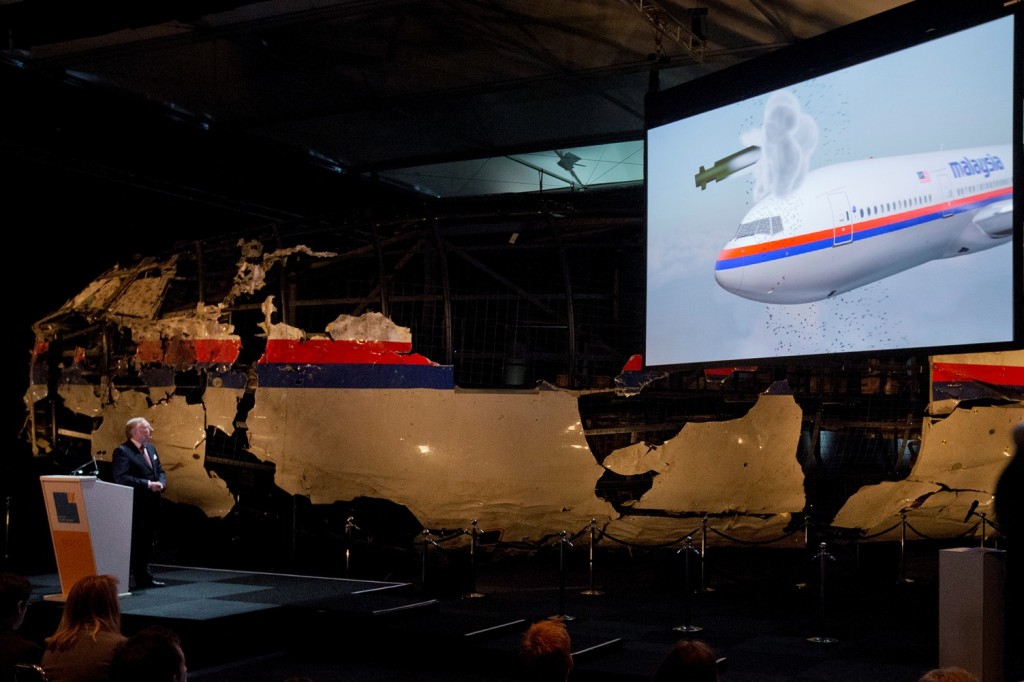- California Assembly OKs highest minimum wage in nation
- S. Korea unveils first graphic cigarette warnings
- US joins with South Korea, Japan in bid to deter North Korea
- LPGA golfer Chun In-gee finally back in action
- S. Korea won’t be top seed in final World Cup qualification round
- US men’s soccer misses 2nd straight Olympics
- US back on track in qualifying with 4-0 win over Guatemala
- High-intensity workout injuries spawn cottage industry
- CDC expands range of Zika mosquitoes into parts of Northeast
- Who knew? ‘The Walking Dead’ is helping families connect
Dutch probe: Buk missile downed Malaysian jet in Ukraine

A video show the impact of a missile on Malaysia Airline Flight 17, while a part of the reconstructed forward section of the fuselage is displayed behind, as Tjibbe Joustra, left, head of the Dutch Safety Board presents the board’s final report into what caused Malaysia Airlines Flight 17 to break up high over Eastern Ukraine last year, killing all 298 people on board, during a press conference in Gilze-Rijen, central Netherlands, Tuesday, Oct. 13, 2015. (AP Photo/Peter Dejong)
GILZE-RIJEN AIR BASE, Netherlands (AP) — The missile shot skyward from war-ravaged eastern Ukraine. With deadly accuracy more than six miles up, it detonated just in front of the Malaysia Airlines jetliner, sending hundreds of jagged steel shards ripping through its aluminum skin at up to 5,600 mph and shearing the cockpit from the rest of the plane.
The two pilots and purser in the cockpit died instantly, and the Boeing 777 disintegrated and fell to earth, killing the rest of the 298 men, women and children aboard Flight 17 on July 17, 2014, Dutch investigators said Tuesday in a long-awaited report.
Some of the victims may have been conscious for 60 to 90 seconds, the Dutch Safety Board said, but they probably were not fully aware of what was happening in the oxygen-starved, freezing chaos. The tornado-like airflow surging through the doomed jet as it came apart was powerful enough to tear off people’s clothes and leave naked corpses amid the fields of sunflowers.
The 15-month Dutch investigation blamed a Soviet-made surface-to-air Buk missile for downing the Amsterdam to Kuala Lumpur flight, but it did not explicitly say who had fired it. It identified an area of 320 square kilometers (120 square miles) where it said the launch must have taken place, and all of the land was in the hands of pro-Russian separatists fighting Ukrainian forces at the time of the disaster, according to daily maps of fighting released by the Ukrainian National Security Council.
The Dutch Safety Board also found that the tragedy wouldn’t have happened if the airspace of eastern Ukraine had been totally closed to passenger planes as fighting raged below.
“Our investigation showed that all parties regarded the conflict in eastern part of Ukraine from a military perspective. Nobody gave any thought of a possible threat to civil aviation,” Safety Board chairman Tjibbe Joustra said in releasing the report at a military base in the southern Netherlands.
He spoke in front of the partially reassembled red, white and blue Malaysian jetliner, much of the left side of its mangled fuselage front riddled with shrapnel holes.
Russian officials were prompt to dismiss the Dutch report, with Deputy Foreign Minister Sergei Ryabkov calling it an obvious “attempt to make a biased conclusion, in essence to carry out a political order.”
Earlier Tuesday, the Buk’s manufacturer presented its own report trying to clear the separatists, and Russia itself, of any involvement.
The Russian state-controlled consortium Almaz-Antey said it conducted experiments, including one in which a Buk missile was detonated near the nose of an airplane similar to a 777, and it contended they contradicted the conclusion that a Buk missile of the kind used by the Russians destroyed Flight 17. Almaz-Antey had earlier suggested that it could have been a model of Buk that is no longer in service with the Russian military but is part of Ukraine’s arsenal.
It said the experiments also rebutted claims the missile was fired from Snizhne, a village that was under rebel control. An Associated Press reporter saw a Buk missile system in that vicinity on the same day.
Despite the moves by Moscow, Prime Minister Mark Rutte of the Netherlands called on Russia to fully cooperate with a separate criminal investigation that Dutch prosecutors are conducting into the downing of the plane, in which 196 Dutch nationals died.
Rutte said a key priority “is now tracking down and prosecuting the perpetrators.”
“On July 17, 2014, in eastern Ukraine, in broad daylight, a passenger airplane was shot out of the sky with a Buk missile,” he said. The safety board’s conclusions confirmed “some of our most shocking suspicions,” he added.
In a statement, the Dutch-led Joint Investigation Team said it has already identified “persons of interest” in the probe, but said it is “not easy” to find witnesses, especially ones willing to make a statement. They said their probe will stretch into 2016.
The Netherlands has headed the international investigation into the disaster because most victims were Dutch. Ukraine, in whose airspace the incident occurred, agreed to let the Netherlands take the lead.
At U.N. headquarters, Ukrainian Foreign Minister Pavlo Klimkin defended his country’s decision not to close its airspace, saying no one at the time was aware of the possibility that Russia had brought highly sophisticated anti-aircraft missiles into Ukraine.
Klimkin also praised the Dutch report as “fully unbiased and transparent,” and said what now is needed is for a criminal investigation to reveal the chain of command and bring those responsible to justice.
Malaysia’s Prime Minister Najib Razak also said the world “must move forward toward ensuring that those responsible are held accountable for this murderous act.” There were 43 Malaysians aboard, the second-highest total.
Australian Foreign Minister Julie Bishop said on Wednesday that her government would not been bullied by Russia in Australia’s pursuit of justice.
Bishop told Seven Network television that a criminal investigation of the “atrocity” will continue.
“We certainly won’t be bullied by anyone in our pursuit of justice for the families of those aboard,” Bishop told the Seven Network.
Australia had the third largest number of victims with 39 Australian citizens and permanent residents aboard.
Dutch investigators said the missile detonated less than a meter (3.3 feet) from the plane, to the left side of the cockpit, sending the shrapnel into the plane at speeds of up to 9,000 kph (5,600 mph).
Joustra said missile fragments found in the cockpit crew’s bodies, as well as paint traces, helped investigators to identify the Buk. Some of the pieces of metal, he said, were shaped like cubes or “bow ties” — a detail weapons experts called extremely significant.
“The overall picture is conclusive — a 9M38M1 surface-to-air missile from a Buk operated from rebel-held territory in east Ukraine was responsible for the shooting down of MH17,” said Nick de Larrinaga, Europe editor for IHS Jane’s Defense Weekly.
Joustra said the Russian government had been given the opportunity to review the report’s conclusions in advance, and that it maintained it was impossible to determine the type of missile or warhead that struck the Boeing with certainty.
The missile explosion caused a “deafening sound wave” anyone still alive aboard would have heard, the Dutch report said.
The sudden decompression, reduced oxygen levels and extreme cold of minus 40-50 degrees Celsius (minus-40-58 degrees Fahrenheit) may have killed some people. As the high winds tore through the cabin, hand baggage and other personal belongings may have become lethal projectiles.
As the mangled, pilotless jet went into its deadly dive from 33,000 feet, those who hadn’t already died may have suffered dizziness, nausea and, finally, blackout and death.
Rob Fredriksz, whose son Bryce was aboard Flight 17, said he was relieved to hear that the passengers died almost instantly and “absolutely felt and knew nothing.”
Paul Guard, an Australian man whose parents Jill and Roger died aboard Flight 17, said on Wednesday he believes the Russians aren’t the only ones at fault.
“Russia’s got a role and they haven’t been very helpful. So I blame Russia partially but not completely. There are many other players that are also to blame,” Guard told Nine Network television in the Queensland state capital Brisbane.
Key findings of the investigation were given to families of victims before the report was released, and Fredriksz said some relatives became emotional when they were shown an animation portraying the downing of the plane.
On Tuesday evening, President Vladimir Putin’s spokesman, Dmitry Peskov, said Russia was disappointed its experts hadn’t been invited to take part in the Dutch investigation, adding that the refusal to take the findings of the Buk manufacturer’s experiments into account reflected a biased approach.
Commenting on Ukraine blaming Russia-backed separatists for downing the plane, Peskov said that “prior to the completion of the probe, it’s inadmissible to put labels and name culprits.”
U.S. National Security Council spokesman Ned Price said the Dutch investigation was conducted in a professional manner and should serve as the basis for further work to identify those responsible for the aircraft’s destruction.
In the village of Hrabove where the jet came down, Lyudmila Grigoryak — whose house was the closest to the crash site — brought red carnations Tuesday to the field where small pieces of the fuselage are still scattered.
Unlike a year and a half ago when heavy fighting was just nearby, the area is quiet and deserted. All the camouflaged rebels who were patrolling the area and manning checkpoints are gone.
___
Corder reported from The Hague, Netherlands. Nataliya Vasilyeva, Jim Heintz and Vladimir Isachenkov in Moscow, Raf Casert in Brussels, Mstyslav Chernov in Hrabove, Ukraine, Jamey Keaten in Geneva, Edith M. Lederer at the United Nations and Nancy Benac in Washington contributed to this report.

















kelly
November 24, 2017 at 8:26 AM
Very nice and always successful.
This is a very good article.
I’m waiting for you the other article.
togel sgp